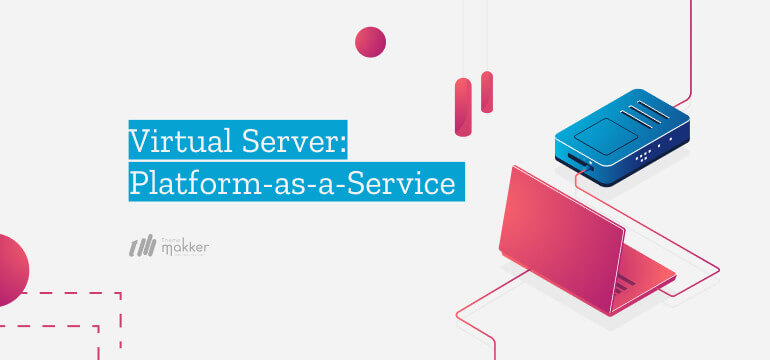-

September 21, 2020
Virtual Server: Platform-as-a-Service
Virtual Server is a server that shares hardware and software resources with other operating systems (OS), versus dedicated servers. Because they are cost-effective and have faster resource control. Virtual servers are popular in web hosting environments.
Platform-as-a-Service (PaaS): Platform-as-a-Service or platform-based service is a category of cloud computing service that provides a platform allowing customers to develop, run, and manage applications without the complexity of building and maintaining the infrastructure typically associated with developing and launching an app. PaaS can be delivered in three ways.
As a pubic cloud service from a provider, where the consumer controls software deployment with minimal configuration options and provider provides the networks, server, storage, Operating Systems, middleware, database, and other services to host consumer applications.
As a private service behind a firewall.
As software deployed on public infrastructure as a service.
In April 2008, Google launched App Engine, with a free trial version limited to 10,000 developers. This was said to have “turned the internet cloud computing space into a fully-fledged industry virtually overnight”. The original intent of PaaS was to simplify the writing of code, with the infrastructure and operations handled by the PaaS provider. Originally, all PaaSes were in the public cloud. Because many companies did not want to have everything in the public cloud, private and hybrid PaaS options were created.
The advantages of PaaS are primarily that it allows for higher-level programming with dramatically reduced complexity; the overall development of the application can be more effective, as it has built-in/self-up-and-down ramping infrastructure resources; and maintenance and enhancement of the application is thus easier.
Disadvantages of various PaaS providers as cited by their users include increased pricing at larger scales, lack of operational features, reduced controls, and the difficulties of traffic routing systems.
AWS Elastic Beanstalk, Heroku, Windows Azure, OpenShift, Apache, Stratos, Magento commerce Cloud are the known example of PaaS.
AWS Elastic Beanstalk:
- AWS elastic beanstalk is the fastest and simplest way to get web applications up and running on AWS. Developers simply upload their application code and the service automatically handles all the details such as resources provisioning, load balancing, auto-scaling, and monitoring.
- Elastic Beanstalk provides an additional layer of abstraction over the bare server and OS. AWS elastic beanstalk is an easy to use service for deploying and scaling web applications and services developed with Java, .NET, PHP, Node.JS, Python, Ruby, Go, and Docker on familiar servers such as Nginx, Passenger, and IIS.
Features of AWS Elastic Beanstalk:
- Wide Selections of Application Platforms: AWS Elastic Beanstalk supports web applications in written in many popular languages and frameworks. It requires no minimal code changes to go from the development machine to the cloud. You can choose from a variety of application platforms such as Java, .NET, Node.js, PHP, Python, Ruby, and Docker to deploy your web applications.
- Variety of Application Deployment Options: AWS Elastic Beanstalk allows you to deploy your code through the AWS management console, Elastic Beanstalk Command Line Interface, Visual Studio, and Eclipse.
- Monitoring: AWS elastic beanstalk provides a unified user interface to monitor and health of your application. Elastic Beanstalk health dashboard allows you to visualize overall application health and customize application health checks, health permissions, and health reporting in one unified interface. Elastic Beanstalk is integrated with Amazon CloudWatch and AWS X-Ray. You can leverage the monitoring dashboard to view key performance metrics, such as latency, CPU utilization, and response codes.
- Management and Updates: You can choose to have AWS elastic beanstalk automatically update to the latest version of your elastic beanstalk environment using Managed platform updates. The immutable deployment mechanism ensures.
- Scaling: AWS Elastic Beanstalk leverages elastic load balancing and auto-scaling to automatically scale your application in and out based on your application’s specific needs.
- Compliance: Elastic beanstalk meets the criteria for ISO, PCI, SCO 1, SOC 2 and SOC 3 compliance along with the criteria for HIPAA eligibility. This means that applications running on elastic beanstalk can progress regulated financial data or protected health information (PHI).
Benefits:
- Fast and simple to begin: Elastic Beanstalk is the fastest and simplest way to deploy your application on AWS. You can simply use AWS management console, a Git repository, or an ide like eclipse, VS code or Atom to upload your application.
- Impossible to Outgrow: Elastic Beanstalk automatically scales your application’s specific need using adjustable auto scaling settings.
- Developer Productivity: Elastic beanstalk provisions and operators the infrastructure and manages the application stack for you, so you don’t have to spend the time or develop the expertise. It will also keep the underlying platform running your application running up to date with latest patches and updates.
- Complete resource Control: AWS elastic beanstalk lets you full control over the AWS resources powering your application.
AWS elastic beanstalk has no additional charges for service. You can pay for AWS resources and create and run your application.
At the end of the discussion you can tap into the AWS community knowledge to help with development through the AWS Elastic Beanstalk.
For 5+ years, we are reliable service providers to our customers with the essential goal of consistently delivering quality. Our strength lies in shared ideas and returns to the community.